


This Month in Aviation History
Aircraft of the Month for October 2000
Convair F-106 Delta Dart
by Alex Stoll
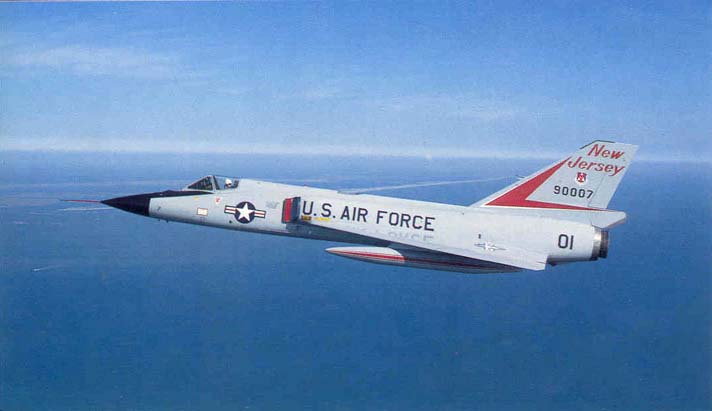
A New Jersey ANG F-106A from the 119th FIS (in the 117th FIG)




A New Jersey ANG F-106A from the 119th FIS (in the 117th FIG)
The F-106A featured a similar wing to the F-102A, but the fuselage was new and slimmer and new engine inlets were positioned almost at the wing leading edge (farther back than on the F-102). Other changed from the F-102A included a broad truncated vertical stabilizer, twin steerable nosewheels, a new radar, and an integrated electronic fire-control and navigation system (the Hughes MA-1) and missile system. The new inlets also included variable geometry intake ramps, which helped to maintain inlet stability and increase engine performance.
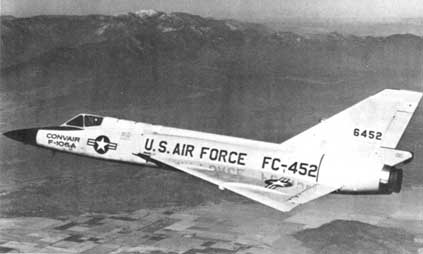
In July 1959, after these changes, the first F-106 was delivered to the USAF Air Defense Command at the 498th Fighter Interceptor Squadron at Geiger Field, Washington. Initial operating capability was achieved in October. On 15 December 1959, Major Joe Rogers set a single engine world speed record of 2456.78 kph (1326.04 kts/1525.95 mph) at 12,200m (40,000 ft) over Edwards Air Force Base. In 1960 the F-106 flew 2415km (1300nm/1500 mi) without refueling. Production ended in December 1960, and the last F-106 was delivered on 20 July 1961.
Many problems turned up in the F-106 when it was subject to service use, such as generator defects, fuel flow deficiencies, and fuel combustion starter malfunctions. All F-106s were grounded in December 1959 after a canopy had unintentionally jettisoned in flight. These problems were fixed by updating the aircraft to Model 8-31/32 standards through programs such as Wild Goose, which was initiated in September 1960.
F-102C
The F-102C was proposed by Convair before the F-106 entered service. It made use of a a more powerful J57-P-47 and a newer MG-14 fire control system for the MB-1 rocket and Falcon missiles. The USAF wanted the F-106, however, instead of more interim aircraft, and none were built.
Pratt & Whitney J75-P-17
The J75, a twin-spool turbojet, was substantially more powerful than the F-102's J57: the J75 produced 76.5 kN (17,200 lbs) at max military power, the same as the F-102 at full afterburner. The J75 had a split fifteen-stage axial flow compressor, composed of an eight-stage low-pressure rotor and a seven-stage high-pressure rotor. The low-pressure rotor was connected to the second- and third-stage turbine wheels with a solid shaft. The J75 also had eight radially mounted combustion chambers, a split three-stage turbine, and an afterburner with a two-position exhaust nozzle. The throttle controlled the high-pressure sections of the engine, but the low-pressure sections were not controllable by the pilot.
F-106B
The F-106B, Convair Model 8-27, was a two-seat combat trainer version. Sixty-three were ordered on 3 August 1956, it was initially meant to be a pure trainer and designated TF-106B, later changed to TF-106A. Later that month the designation was changed again to F-106B when the USAF wanted full combat capability for it. The pilots were seated in tandem to avoid the problems experienced with the TF-102A, which seated the two pilots side-by-side. Some of the avionics were moved to the weapons bay. It retained full operational capability for launching Falcons or Genies. The MA-1 was replaced with an equivalent fire-control system, the Hughes AN-ASQ-25. The cockpit was higher (28.4 cm/11.2 in higher at its highest point) than on the one-seater to give the rear-seat pilot better visibility. The intrumentation is simpler in the aft cockpit, but the front cockpit's instrument panel is nearly the same as on the A. The side consoles in the front cockpit are less cluttered. Because of the larger cockpit, the fuselage tank behind the pilot that normally holds 858 L (227 gallons) only holds 442 L (117 gallons), but the wing tanks are a little larger. When the ejection handgrips are lifted, after the canopy is jettisoned, the rear seat's rockets fire about one second before the front seat's, to avoid collision of the pilots.
The first eight F-106Bs were designated JF-106Bs during flight tests. The first F-106B was delivered in February 1959, but the same problems experienced with the F-106A were also experienced in the B, and it was not fully operational until July 1960. Production ended in December 1960. All of the sixty-four F-106Bs built were built with the newer supersonic ejection seats. Two F-106Bs, 57-2507 and 57-2516, were transfered to NASA and redesignated NF-106Bs as systems development aircraft. The civilian registrations N607NA and N616NA, respectively, were used. 57-2516 was transfered to Langley Research Center in October 1966 used for R&D for supersonic engine inlet design and assigned NASA number 616. Two additional jet engines were later mounted under the wings. In January 1979, 616 was transfered Dryden Flight Research Facility at Edwards AFB and redesignated 816. It was loaned to Langley later that year for research into aircraft lightning strikes. In 1988, it was fitted with wing leading edge vortex flaps designed and manufactured by Langley for the Advanced Tactical Fighter program. Since then, the aircraft has been retired.
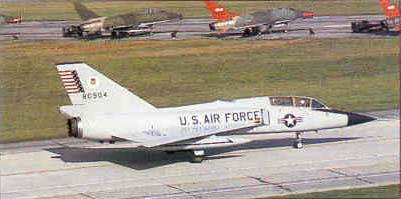
Armament
The F-106 had a similar but more advanced armament than the F-102A. It held one AIM-2A Genie nuclear rocket, which could shoot down the target from 300m (1000ft) away, and four AIM-4 Falcon missiles, usually two AIM-4F SARH Super Falcons and two AIM-4G IR Super Falcons. Later a 20mm cannon was added.
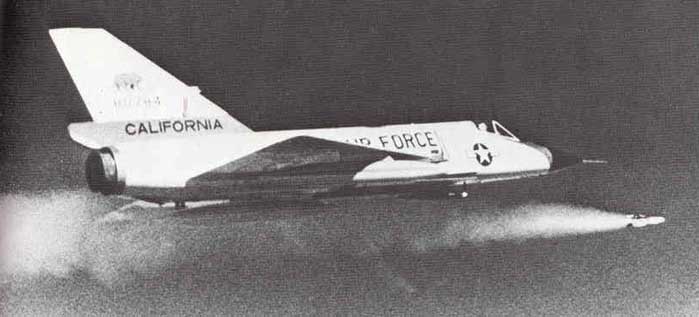

An F-106 launches a Genie
(Photo courtesy of Pat's World F-106 Delta Dart)
The weapons bay is over a quarter the length of the aircraft. All the weapons are carried in the bay to minimize drag. The only things carried on external hardpoints are the drop tanks (and sometimes chaff dispensers or some missiles): the supersonic tanks could hold 1360 L (360 gallons) and were Mach 2 rated; the subsonic tanks could hold 870 L (230 gallons).
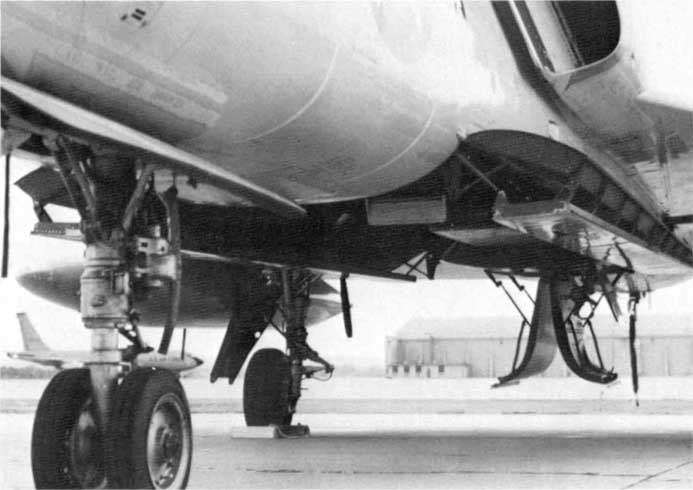
Cockpit
The pilot entered the cockpit from the left side of the fuselage with a tubular steel ladder hooked over the cockpit edge.
Consoles ran along both sides of the ejection seat and the instrument panel. The throttle lever, a fuse block, a spare fuse holder, an anti-g-suit selector switch, fuel tank transfer switches, a canopy opening and closing switch (emergency and automatic), oxygen system controls, the landing light switch, radar horizontal and vertical scan control switches, weapons bay switches for missile arming, an emergency hydraulic pump, and a T-handle were located on the left console. The right console contained the radio equipment (navagitional and communications). Most of the more important instruments, like the altimeter and speedometer, were displayed with vertical tape on the instrument panel in front of the pilot on the newer aircraft. The tape instruments were much easier to read than the conventional ones, but they were harder to maintain and service.
The enigne RPM, temperature gauges, fuel and oil level gauges, and autopilot controls were also located on this instrument panel. On the upper left of the control panel was the drag chute control handle. Pulling the handle deployed the chute, and pushing it back in jettisoned it. However, the chute was usually dragged by the aircraft to the ramp, so someone didn't have to go down and retrieve it from the runway or taxiway. In the center, from top to bottom, were the radar scope, the attitude controller display, compass, and tactical situation display. The optical sight for visual missile firing and M61 aiming was high in the triangle formed by the windscreen.
The stick formed a double-handle U-shape from its central shaft rooted in the floor. The pilot held on with both hands and could control the weapons and attack functions with switches and buttons.
Fuel
The F-106 used JP-4. The maximum internal fuel capacity of the F-106A was 5723 L (1514 gallons), including 113 L (40 gallons) in the fuel lines. There was a 151-L (40-gallon) fuselage tank located behind the pilot and a 858 L (227 gallon) tank directly behind the pilot on the upper side of the fuselage on the F-106A. Four fuel tanks were located in each wing, one of which was a transfer tank. The number one tanks were located at the leading edges and held 866 L (229 gallons) combined. Aft of the number one tanks, past a wing spar, the landing gear wells, and another wing spar, were the number two and three tanks, which held 1176 L (311 gallons) and 1603 L (424 gallons), respectively. The transfer tanks, located between the aft spar and the elevons, held 1588 L (420 gallons) combined. The F-106A could hold 7439 L (1968 gallons), or 5808 kg (12,792 lbs) of fuel, including the external drop tanks. The F-106B's maximum capacity was 7318 L (1936 gallons), or 5713 kg (12,584 lbs), due to the smaller tank in the fuselage. Directly aft of the 858-L (227-gallon) tank was the aerial refueling hatch.
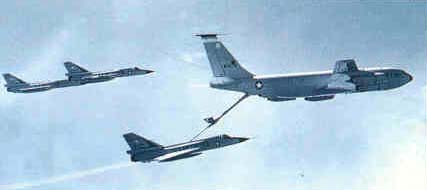
Hughes MA-1 "Digitair"
The MA-1, a high-capacity digital computer, was designed to be digitally datalinked to the SAGE and was composed of 200 black electronic metal black boxes packed with thousands of tiny electronic parts and almost thirteen kilometers (eight miles) of wiring. All together it weighed 1145 kg (2520 lbs). The electronics were wrapped completely around the pilot except over him. It included automatic datalink reception and automatic flight control for navigation. Continuous position determination through the TACAN (tactical air naviagation) station and automatic navigation to any of several preselected waypoints were possible. After takeoff, the system could fly the F-106 to the target, launch the missiles, monitor the return trip to base, and return controls to the pilot just before landing. The pilot could follow his progress on a round 20-cm (eight inch) tactical situation display that showed film strips of approaching air navigiation maps. Each strip showed all major ground references up to about a 650-km (350-nm/400-mi) radius of the operations base. The strips could be changed when the F-106s operated from different bases. A small black delta wing symbol with a needle nose (the "bug") was superimposed on the map to indicate the position of the aircraft. The current range of the aircraft was represented by a circle on the map centered on the "bug." Under SAGE, the target was represented by an "X" bisected with an arrow. The navagation system could turn the aircraft on to an attack course, and markers on the radar scope approximated the range, azimuth, and elevation of the target. Once the target was obtained, the pilot could compelete the interception without SAGE.
The firing order of the aircraft's armament was selected by the pilot. A circle on the radar scope maked where the target was estimated to be, and when it came within radar range, a blip appeared marking its position.
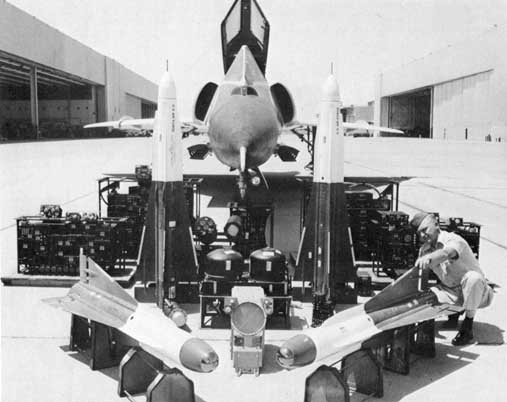
Upgrades
The last F-106As and Bs off the assembly line were up to Model 8-31 and 8-32 standard, respectively. These new standards included upgrades to the MA-1, supersonic ejection seats, vertical-tape instruments, wings with modified camber (which were tested on 57-0246), and the ability to carry 870-L (230-gal) external drop tanks on wing pylons.
Later in its service life, the F-106 was almost continuously updated. It received a new ejection seat (the original supersonic seat was replaced during 1965-1967 with a "Weber" seat), mid-air refueling capability, supersonic drop tanks, a clear top canopy (added in 1972), new onboard systems, and internal M61 cannon, and a sensitive IR seeker. The General Electric M61 Vulcan cannon, added to some F-106As in 1973 after experience from the Vietnam War proved it neccessary, was semi-retractable and fit into a bulge about fifteen centimeters (six inches) high and ninety centimeters (three feet) long in the weapons bay. It held 75 highly explosive and incendiary shells (twenty of which were sufficient to down a bomber) and replaced the Genie. The spent round were stored in the weapons bay. The supersonic fuel tanks could hold 1740 L (360 gal) each and gave the F-106A a 4350km (2345nm/2700 mi) range at 982 kph (530 kts/610 mph) at 12,200 m (40,000 ft). The last aircraft were retired from the New Jersey Air National Guard (the 177th Fighter Group, in Atlantic City) in 1988.

F-106X (C/D)
The F-106X was a 1956 design study for a follow-on aircraft to the F-106A/B. It had canards and used the JT4B-22 turbojet with rectangular intakes to propel it to Mach 5. The fire control system was to have been connected to a radar with a 102-cm (40-in) dish. Later it was redesignated F-106C/D, the C having one seat and the D having two. The Air Force considered buying 350, but it cancelled the project on 23 September 1958. After the cancellation of the project, two modified F-106As, 57-239 and 57-240, tested the new radar housing with 1.5 meter (five-foot) nose extensions with ten flights in 1959.
QF-106
Many F-106s were converted to QF-106 ground-controlled target drones by Honeywell. Two propane burners under the wings increased the IR signature. The first QF-106 was converted in 1990, and the USAF planned to convert 194.

| Model 8-24 | Interceptor; main variant | |
| Model 8-27 | Trainer version of F-106A | |
| F-106C/D (F-106X) | Model 8-28/29 | Advanced follow-on versions |
| F-106E/F | Proposed versions with look-down radar in an elongated nose | |
| Drone version; modified from F-106A | ||
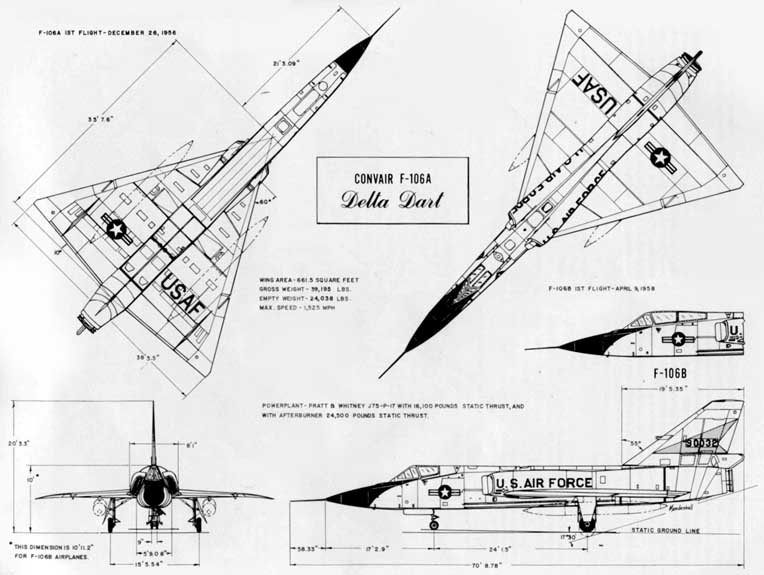
Convair F-106 Specifications An F-106A from the 87th FIS | ||
| F-106A | F-106B | |
|---|---|---|
| Type | ||
| Powerplant | One Pratt & Whitney J75-P-17 twin-spool turbojet, rated @ 76.5 kN (17,200 lb) thrust and 109.0 kN (24,500 lb) thrust with afterburner | One Pratt & J75-P-17, rated @ 75.6 kN (17,000 lb) thrust and 106.7 kN (24,000 lb) thrust with afterburner |
| Crew | ||
| Armament | ||
| First flight | ||
| Number built | ||
| USAF Serial Numbers | F-106A-65-CO 3 built 57-2453 through 57-2455 F-106A-70-CO 5 built 57-2456 through 57-2460 F-106A-75-CO 5 built 57-2461 through 57-2465 F-106A-80-CO 12 built 57-2466 through 57-2477 F-106A-75-CO 8 built 57-2478 through 57-2485 F-106A-90-CO 21 built 57-2486 through 57-2506 F-106A-95-CO 13 built 58-759 through 58-771 F-106A-100-CO 27 built 58-772 through 58-798 F-106A-105-CO 30 built 59-001 through 59-030 F-106A-110-CO 29 built 59-031 through 59-059 F-106A-120-CO 27 built 59-060 through 59-086 F-106A-125-CO 25 built 59-087 through 59-111 F-106A-130-CO 24 built 59-112 through 59-135 F-106A-135-CO 13 built 59-136 through 59-148 | |
| Performance | ||
| Max speed | ||
| Max maneuvering speed | ||
| Range | ||
| Combat Radius | ||
| Service Ceiling | ||
| Zoom Climb Alt | ||
| Initial Climb Rate | ||
| Weights | ||
| Empty | ||
| MTOW for area interceptor mission | ||
| MTOW | ||
| Dimensions | ||
| Wingspan | ||
| Length | ||
| Height | ||
| Wing Area | ||
|
2 Oct 1966 - First flighty of the Gulfstream II 5 Oct 1967 - First flight of the SS-2 6 Oct 1956 - First flight of the Alizé prototype 6 Oct 1977 - First flight of the MiG-29 prototype 6 Oct 1977 - The last (209th) Buccaneer was delivered to the RAF 6 Oct 1984 - First flight of the IA-63 prototype 7 Oct 1995 - First flight of the FS-X (F-2) prototype 9 Oct 1987 - First flight of the EH 101 9 Oct 1999 - First flight of the 767-400ER 10 Oct 1976 - First flight of the EMB-121 12 Oct 1954 - First flight of the XT-37 14 Oct 1947 - The X-1 broke the sound barrier 15 Oct 1988 - First flight of the BO 108 16 Oct 1974 - First flight of the SS-2A 21 Oct 1960 - First hovering flight of P.1127 |
21 Oct 1961 - First flight of the Atlantic 22 Oct 1955 - First flight of the F-105 prototype 22 Oct 1963 - First flight of the YAT-37D 23 Oct 1951 - The B-47 entered service 23 Oct 1967 - First flight of the CL-215 23 Oct 1984 - The first Dash 8 was delivered (to an airline) 25 Oct 1955 - First flight of the J 35 prototype 25 Oct 1990 - First supercruise by a YF-22 26 Oct 1943 - First flight of the Do 335V1 prototype 26 Oct 1962 - Igor Sikorsky died of a heart attack at 83 26 Oct 1968 - First flight of the YC-95 26 Oct 1973 - First flight of the Alpha Jet prototype 26 Oct 1990 - First flight of the second YF-23 27 Oct 1979 - First flight of the Tornado ADV 29 Oct 1956 - Taxi test of the YB-58 began |